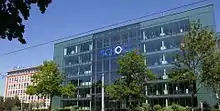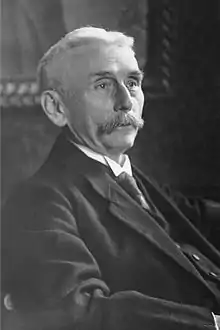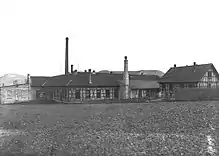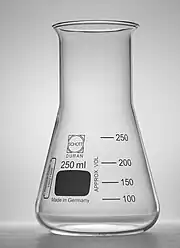 | |
 | |
| Type | Aktiengesellschaft |
|---|---|
| Industry | Glass |
| Founded | 1884 Jena, Germany |
| Founder | Otto Schott |
| Headquarters | , |
Key people | Frank Heinricht (Chairman of the Management Board) |
| Services | Glass Manufacturing |
| Revenue | 2.8 billion euro (2022)[1] |
| Owner | Carl-Zeiss-Stiftung |
Number of employees | 17,213[2][note 1] |
| Website | schott |
Schott AG is a German multinational glass company specializing in the manufacture of glass and glass-ceramics. Headquartered in Mainz, Germany, it is owned by the Carl Zeiss Foundation. The company's founder and namesake, Otto Schott, is credited with the invention of borosilicate glass.
History
Founding


In 1884, Otto Schott, Ernst Abbe, Carl Zeiss and his son Roderich Zeiss founded the Glastechnische Laboratorium Schott & Genossen (Glass Technical Laboratory Schott & Associates) in Jena,[3][4] which initially produced optical glasses for microscopes and telescopes.[5] In 1891, the Carl Zeiss Foundation founded two years earlier by Ernst Abbe became a partner in the glass laboratory.[6] Jena glass, an early borosilicate glass, was one of its early manufactured products.[7] The invention of borosilicate glass, resistant to chemicals, heat and temperature change, paved the way for new technical glasses for thermometers, laboratory equipment and gas lamps.

The company experienced economic success. The workforce had grown to 1,233 by 1919.[8] Sales had doubled to 28 million marks by 1920. Otto Schott transferred his shares to the Carl Zeiss Foundation in 1919, fully rendering the glass laboratory a foundation company and renaming it Jenaer Glaswerk Schott & Gen (Jena Glassworks Schott & Assoc.).[9][10] Erich Schott, the founder's son, took over management of the glass factory in 1927. Erich Schott founded new production areas for specialty glass components used in electrical engineering as well as heat resistant borosilicate glassware for household use.[11]
Split
In the midst of Germany's political division after World War II, the Jena factory was expropriated and transformed into a Publicly Owned Enterprise (VEB) in 1948. The company was divided in half: VEB Jenaer Glaswerk in Jena in East Germany, later integrated into the VEB Carl Zeiss Jena collective, and Jenaer Glaswerk Schott & Gen in Mainz in West Germany.[12][13] While VEB Jenaer Glaswerk developed into a specialty glass supplier in the Eastern Bloc, the other half developed into an international group in Mainz with sales offices abroad.[14] The company became a specialist glass manufacturer with products including glass components for television tubes, fiber optics for light and image conductors, mirror substrates for giant telescopes, glass-ceramic cooktop panels (serial production from 1973) and glass tubes for parabolic trough power plants. Following the German reunification, the Mainz plant assumed Jena's company shares.[14]
Late 20th century
The company experienced growth in the first decade after the fall of the Berlin Wall. Schott Glas, as it became known in 1998, developed into a technology group with 80 companies in 32 countries and global sales of over 3 billion Deutschmark. Schott had been operating at only 40 sites in ten countries with global sales of DM 1.31 billion in 1984. In 2004, Schott Glas converted from a dependent enterprise of its sister enterprise Carl Zeiss (Oberkochen) to become a legally independent Aktiengesellschaft—Schott AG.[15] The Carl Zeiss Foundation remains the sole shareholder of Schott AG. The Foundation Statute does not permit to sell its shares, ruling out the prospect of an IPO.
Solar industry
The technology group entered the solar industry in 2001, founding Schott Solar GmbH in 2005 (renamed Schott Solar AG in 2008). In 2008, Schott announced that it planned to produce crystalline photovoltaic cells and modules with a total of 450 MW annually. It also planned to produce thin-film PV wafers with a capacity of 100 MW.[16][17] In 2009, the company inaugurated a US$100 million solar manufacturing facility in Albuquerque, New Mexico, USA to build solar receivers for concentrated solar thermal power plants (CSP) and 64 MW of photovoltaic modules. They had already been making 15 MW of photovoltaics annually in Billerica, Massachusetts, until the factory was closed in 2009.[18] The company was also engaged in concentrated solar power technology, by manufacturing solar receiver tubes. In June 2012, Schott announced that its Albuquerque plant would close down, laying off all photovoltaic cell manufacturing employees immediately and ramping down the remaining employees over the rest of the summer.[19] Schott withdrew from its solar business in 2012 and Schott Solar AG was dissolved.
Company profile
The supervisory board appointed Frank Heinricht as chairman of the board of management of Schott AG in June 2013.[20] Heinricht, a German physicist with a doctorate in engineering,[21] succeeded Udo Ungeheuer, who had served as chairman from 2004.
SCHOTT AG established a glass manufacturing facility in India in Jambusar, Gujarat in 1998 under its Indian subsidiary, SCHOTT Glass India Pvt. Ltd.. The plant produces Type I pharma tubing glass, which is used to make pharmaceutical packaging products such as ampoules, vials, syringes and cartridges.
The German Group also has a 50-50 Joint venture in India with KAISHA Group of Companies, as SCHOTT KAISHA Pvt. Ltd. which produces pharmaceutical packaging products.
The company started operating in China since 2011,[22] with a large production.
SCHOTT reported sales worth 2.05 billion Euros in its fiscal year 2016–2017.[23] In 2017–2018 sales increase to 2.08 billion euros with an annual profit of 208 million euros. In 2019, SCHOTT reported sales worth 2.2. billion Euros with an annual profit of 206 million euros. SCHOTT AG employs around 16.200 people in production and sales facilities in 34 countries, including around 5,800 in Germany (as of 2019).[24] SCHOTT increased its global sales by 2.2% in 2020 to reach 2.5 billion USD, with an improved operating profit (EBIT) of 320 million USD. The number of employees rose to around 16,500.[25]
The sole owner of Schott AG is the Carl Zeiss Foundation, which holds all shares and is partly financed from the dividends.[15]
Plants in Germany
- Mainz: Optical glass, glass-ceramic cooktop panels, fire viewing panels, fiber optics, pharmaceutical tubing
- Grünenplan: Thin glass
- Jena: Fire-resistant glass
- Landshut: Electronic packaging
- Mitterteich: Glass tubing, rods and profiles for technical and pharmaceutical applications
- Müllheim: Pharmaceutical packaging
Products

Schott produces materials including specialty glass, glass-ceramics, and polymers for industries such as home appliances, pharmaceuticals, electronics, semiconductors, optics, life sciences, automotive, aerospace and astronomy.[26]
In the consumer market, glass-ceramics from Schott are used in cooktops for electric, gas, and induction cooking under the brand name CERAN.[27]
In industry, its glass-ceramic Zerodur is used in microlithography and as mirror substrates for large optical telescopes[28] such as:
- European Southern Observatory’s Very Large Telescope and Extremely Large Telescope in Chile,[28]
- Gran Telescopio Canarias in Spain,[29]
- Keck I and II telescopes at the W.M. Keck Observatory in Hawaii.[30]
Other applications include flat glass for home appliances,[31] components for consumer electronics[32] and semiconductor manufacturing[33]. It also produces glass and filters with applications in digital cameras,[34] laser optics, machine vision, and metrology.[35] Some of its more recent applications include ultra-thin and flexible cover glass for smartphone displays[36] and glass wafers for augmented reality.[37]
Schott’s subsidiary Schott Pharma develops and produces pharmaceutical packaging such as ampoules, cartridges, syringes, and vials.[38]
Notes
- ↑ As of 30 September 2022.
References
- ↑ "Annual Report 2021/2022". Schott. p. 4. Retrieved 23 February 2023.
- ↑ "Annual Report 2021/2022". Schott. p. 2. Retrieved 23 February 2023.
- ↑ Kotler, Philip; Pfoertsch, Waldemar (17 May 2010). Ingredient Branding: Making the Invisible Visible. Springer Science & Business Media. p. 237. ISBN 978-3-642-04214-0.
- ↑ Bertele, Erhard (27 March 2019). LUDWIG J. BERTELE: A Pioneer of Geometric Optics. vdf Hochschulverlag AG. p. 27. ISBN 978-3-7281-3955-9.
- ↑ Werner Vogel: Glass Chemistry, 2. Edition, Springer Verlag Berlin Heidelberg 1994, S. 10.
- ↑ "Carl Zeiss (company timeline)". The Collection of Historical Scientific Instruments – Harvard University.
- ↑ Practical Engineer. Technical Publishing Company. 1896. p. 498.
- ↑ Kappler, Dieter; Steiner, Jürgen; Schott AG (2009). Schott : 1884–2009 ; vom Glaslabor zum Technologiekonzern. Mainz: Schmidt. ISBN 978-3-935647-45-8. OCLC 467893033.
- ↑ Pederson, Jay P. (1988). International Directory of Company Histories. St. James Press. ISBN 978-1-55862-393-4.
- ↑ King, Henry C. (January 2003). The History of the Telescope. Courier Corporation. ISBN 978-0-486-43265-6.
- ↑ Steiner, Jürgen (2007). "Schott, Erich". Deutsche Biographie (in German). Retrieved 8 March 2023.
- ↑ Buchholz, Leyla (26 June 2020). "Zug der 41 Glasmacher" (in German). Springer Professional. Retrieved 31 July 2023.
- ↑ "VEB Carl Zeiss Jena: 1948 - 1990". Harvard University. Retrieved 31 July 2023.
- 1 2 "Milestones – The corporate history at a glance". www.schott.com. Retrieved 21 January 2020.
- 1 2 "SCHOTT ist jetzt Aktiengesellschaft" [SCHOTT is now joint-stock company] (in German). Munich: analytica-world news, Messe München GmbH. 2 July 2004. Retrieved 2 December 2019.
- ↑ "Schott AG to build PV production in USA". EETimes. Retrieved 15 March 2016.
- ↑ http://www.schott.com/solar/english/index.html Website Schott Solar
- ↑ "Schott Solar to shutter PV module production facility in Billerica, MA". PV-Tech. 3 June 2009. Retrieved 15 March 2016.
- ↑ Robinson-Avila, Kevin. "Updated: Schott Solar Mesa del Sol Plant To Shut". www.abqjournal.com. Retrieved 15 March 2016.
- ↑ "Frank Heinricht appointed Chairman of the Board of Management of SCHOTT AG". 27 February 2013. Retrieved 21 January 2020.
- ↑ "Frank Heinricht, Schott AG: Profile and biography". Bloomberg News.
- ↑ "Schott Solar to establish 300MW of production in China | Recharge". 28 January 2011.
- ↑ "Annual Report 2016/17". SCHOTT. Retrieved 23 January 2018.
- ↑ "SCHOTT Facts & Figures".
- ↑ "SCHOTT eyes U.S. growth strategy as sales and earnings increase in 2020 | SCHOTT AG". www.schott.com. Retrieved 16 March 2021.
- ↑ "Facts and Figures SCHOTT". schott.com. Schott AG. Retrieved 11 January 2024.
- ↑ Wharton, Rachel (24 August 2023). "The Best Induction Cooktop". nytimes.com. Retrieved 11 January 2024.
- 1 2 Sokach, Stephen (1 July 2020). "ZERODUR: The Highly Technical Glass-Ceramic". techbriefs.com. Retrieved 11 January 2024.
- ↑ "Introducing the Gran Telescopio CANARIAS". www.gtc.iac.es. Retrieved 11 January 2024.
- ↑ "A Mirror's Perfect Reflection". keckobservatory.org. 28 May 2010. Retrieved 11 January 2024.
- ↑ "Processed Flat Glass". schott.com. Retrieved 11 January 2024.
- ↑ "Consumer Electronics". schott.com. Retrieved 11 January 2024.
- ↑ "Semiconductor & Datacom". schott.com. Retrieved 11 January 2024.
- ↑ "Consumer Electronics". schott.com. Retrieved 11 January 2024.
- ↑ "Optics". schott.com. Retrieved 11 January 2024.
- ↑ Hartmann, Ilona (23 May 2023). "SCHOTT Mainz will mit ultradünnem Glas den Smartphonemarkt aufmischen". swr.de (in German). SWR4 Rheinland-Pfalz. Retrieved 11 January 2024.
- ↑ Wallace, John (11 February 2020). "Schott, Inkron, EVG, and WaveOptics team up to fabricate next-gen waveguides for AR and MR devices". www.laserfocusworld.com. Retrieved 11 January 2024.
- ↑ "Germany's Schott to launch medical glassware IPO in late summer". reuters.com. Reuters. 22 June 2023. Retrieved 11 January 2024.